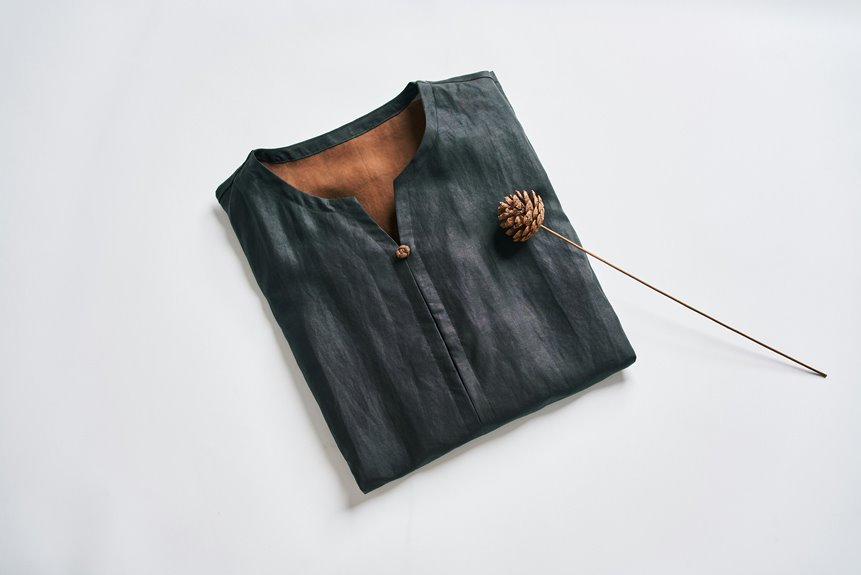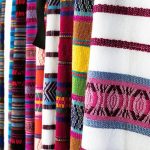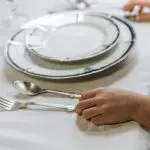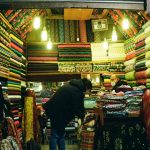When visiting the Shanghai Fabric Market, plan to go to the South Bund Fabric Market near Lupu Bridge for easy metro access. You’ll find sections for silk, cotton, wool, and accessories, with clear quality cues like texture and weave tightness. Prices vary, so bargain politely using cash or digital payments. Shop during weekdays to avoid crowds and engage sellers respectfully for the best experience. Stick around to uncover tips on traversing the market and cultural norms to get even more from your trip.
Table of Contents
Key Takeaways
- The South Bund Fabric Market near Lupu Bridge is the most popular location with easy metro and bus access.
- Fabrics are organized by type, including silk, cotton, linen, wool, and trims, with both wholesale and retail options.
- Check fabric quality through texture, weave tightness, softness, color fastness, and fiber content labels.
- Prices vary by quality and season; bargaining politely and bundling purchases can secure better deals; cash and digital payments are common.
- Visit on weekdays to avoid crowds, interact respectfully with sellers, and familiarize yourself with market layout for a smoother experience.
Location and Accessibility of the Shanghai Fabric Market
Although the Shanghai Fabric Market spans several locations, the most popular one is the South Bund Fabric Market, conveniently situated near the Lupu Bridge.
You’ll find it easy to reach by public transport; both the metro and buses stop close by. If you’re taking the metro, get off at South Bund Station on Line 12, and the market is just a short walk away.
For buses, several routes serve the area, dropping you near the market’s entrances. If you prefer taxis or ride-sharing, the market’s well-known name and location make it simple to direct your driver.
No matter how you choose to get there, you won’t struggle to access this vibrant hub of fabric and textiles in Shanghai.
Overview of Market Layout and Major Sections
The Shanghai Fabric Market is divided into several distinct sections, each catering to different types of textiles and sewing needs.
When you arrive, you’ll find large halls organized by fabric category, like silks, cottons, and synthetics, making it easier to navigate.
There’s also a dedicated area for trims and accessories, so you can grab buttons, zippers, and ribbons all in one stop.
Some sections specialize in wholesale, perfect if you’re buying in bulk, while others focus on retail for smaller purchases.
Don’t miss the tailoring supplies corner, stocked with needles, threads, and tools.
Clear signage and helpful staff guide you through, but having a rough plan aids.
Understanding this layout guarantees you spend less time wandering and more time finding exactly what you need.
Types of Fabrics Available and Their Uses
Exploring the variety of fabrics at the Shanghai Fabric Market reveals options suited for every project and preference.
Whether you’re crafting elegant garments or home décor, you’ll find materials that match your needs perfectly.
Find the perfect fabrics for elegant clothing and stylish home décor at the Shanghai Fabric Market.
As you browse, keep these common fabric types and their uses in mind:
- Silk: Ideal for luxurious dresses and scarves due to its smooth texture and sheen.
- Cotton: Versatile and breathable, perfect for casual wear and bedding.
- Linen: Great for summer clothing and table linens because of its lightness and durability.
- Wool: Best for warm coats and suits, offering insulation and structure.
- Chiffon: Lightweight and sheer, commonly used in evening gowns and overlays.
This knowledge helps you select fabrics that bring your creative vision to life efficiently.
Quality Indicators to Look for in Fabrics
When you shop, pay close attention to fabric texture and weave to judge quality.
Don’t forget to test color fastness by rubbing or washing a small area.
Always check material composition labels to know exactly what you’re getting.
Fabric Texture and Weave
Feel the fabric between your fingers to immediately sense its texture and quality. The weave pattern and surface smoothness tell you a lot about durability and comfort.
As you explore the Shanghai fabric market, focus on these key qualities:
- Tightness of weave: A dense weave usually means higher durability.
- Evenness: Consistent texture without lumps or irregularities signals good craftsmanship.
- Softness: Indicates quality fibers and finishing.
- Weight: Heavier fabric often suggests sturdiness, while lighter ones offer breathability.
- Surface finish: Look for smoothness or intentional texture, depending on the fabric type.
Understanding these elements helps you select fabrics that match your project needs, ensuring your purchase is both beautiful and lasting.
Color Fastness Tests
Although fabric texture reveals much about quality, color fastness tests show how well a fabric will maintain its hue over time.
When you shop in the Shanghai fabric market, ask sellers if their fabrics have undergone these tests. Common tests include washing, rubbing, and light fastness, which simulate wear and exposure to sunlight. Fabrics that pass these tests won’t bleed, fade, or transfer color easily.
You can also do a quick check by rubbing a damp white cloth on the fabric to see if any dye comes off. Prioritizing color fastness guarantees your garments or projects stay vibrant longer, saving you frustration later.
Material Composition Labels
Material composition labels offer essential clues about a fabric’s quality and performance.
When you’re browsing through the Shanghai fabric market, these labels help you identify what you’re really getting. Always check for the fiber content since natural fibers like cotton and silk usually indicate better breathability and comfort.
Synthetic blends can add durability but might affect softness. Look out for the following quality indicators:
- Fiber percentages: Higher natural fiber content often means better quality.
- Weave type: Tight weaves generally suggest durability.
- Country of origin: Some regions are known for superior fabric craftsmanship.
- Care instructions: Proper maintenance guarantees fabric longevity.
- Certifications or quality marks: These validate authenticity and compliance with standards.
Popular Fabrics Unique to Shanghai
When you explore Shanghai’s fabric markets, you’ll find traditional silk varieties that showcase rich heritage.
You’ll also notice innovative textile blends crafted with modern techniques.
Plus, local dyeing methods give these fabrics unique colors and patterns you won’t see anywhere else.
Traditional Silk Varieties
Because Shanghai has a rich history of silk production, you’ll find traditional silk varieties here that you won’t easily encounter elsewhere.
When you explore the markets, pay attention to these exquisite types, each with unique textures and cultural significance:
- Mulberry Silk: The highest quality silk, known for its smoothness and durability.
- Tussah Silk: Made from wild silkworms, with a coarser texture and natural golden hue.
- Doupion Silk: Features irregular slubs, offering a distinctive, rustic appearance.
- Raw Silk: Less processed, retaining natural sericin for a matte finish.
- Shantung Silk: Lightweight with a crisp texture, ideal for elegant garments.
Knowing these will help you pick authentic silk that matches your style and needs perfectly.
Innovative Textile Blends
Shanghai’s fabric markets showcase a handful of innovative textile blends that you won’t find anywhere else. When you explore these markets, you’ll notice fabrics combining traditional silk with synthetic fibers, creating materials that are both luxurious and durable.
These blends often feature moisture-wicking and wrinkle-resistant properties, perfect if you want style and function. You’ll also find cotton-linen mixes that offer breathability with a unique texture, ideal for Shanghai’s humid climate.
Some blends incorporate bamboo fibers, adding natural antibacterial qualities and a silky softness. By choosing these innovative fabrics, you’re tapping into Shanghai’s cutting-edge textile craftsmanship.
Whether you’re designing fashion or crafting home décor, these blends give you versatility and quality that stand out from standard materials.
Local Dyeing Techniques
Vibrant hues and intricate patterns define the local dyeing techniques that make Shanghai’s fabrics truly unique.
When you explore the market, you’ll notice how these time-honored methods bring life to every textile, reflecting both tradition and creativity.
You’ll find artisans skillfully blending colors and patterns, ensuring each fabric tells a story.
Here are some techniques you’ll want to keep an eye out for:
- Batik dyeing, creating bold, wax-resist patterns
- Tie-dye methods producing swirling, vibrant effects
- Indigo dyeing, known for its deep blue shades
- Hand-painted fabric designs, adding artistic flair
- Stencil dyeing, offering precise and repeatable motifs
Understanding these techniques helps you appreciate the craftsmanship behind every piece you consider buying.
Pricing Trends and What to Expect
As you explore the fabric market in Shanghai, you’ll notice that prices can vary considerably depending on factors like material quality, demand, and season.
High-quality silk or specialty fabrics tend to cost more, especially during peak demand periods like fashion seasons or holidays. Cotton and synthetic blends are generally more affordable but watch out for price fluctuations based on supply availability.
New arrivals or trendy fabrics often come with a premium price, while older stock may be discounted. Seasonal changes also influence pricing; for example, heavier fabrics can be pricier in winter.
Keep in mind that prices are usually set per meter, so plan your purchases accordingly. Understanding these trends helps you budget effectively and get the best value on your fabric selections.
Tips for Effective Bargaining and Negotiation
Before you start bargaining, make sure you know the current market prices to avoid overpaying.
Stay polite but persistent, as sellers respect confident buyers who negotiate respectfully.
Try bundling multiple items together to score better discounts and get more value for your money.
Know Market Prices
Although prices can vary widely across Shanghai’s fabric markets, knowing the general price range for the materials you want will give you a strong advantage when bargaining.
Before you start negotiating, do some research online or ask locals to get a sense of typical costs. This way, you won’t be caught off guard by inflated prices. Keep track of prices at multiple stalls to compare effectively. When you know the market rate, you can confidently counteroffer without hesitation.
- Understand price differences for fabric types (silk, cotton, polyester)
- Note wholesale versus retail pricing
- Factor in quantity discounts
- Observe quality variations affecting price
- Keep a mental or written record of prices you encounter
Being informed lets you negotiate smarter, not harder.
Use Polite Persistence
When you’re bargaining at Shanghai’s fabric markets, staying polite yet persistent can make all the difference.
Approach each vendor with respect, using a friendly tone that encourages a positive interaction. Start by asking for their best price, then gently counteroffer without showing frustration or impatience.
If the price doesn’t meet your expectations, calmly express your interest but mention your budget constraints. Vendors appreciate buyers who are firm but courteous, so maintain a steady, confident attitude while avoiding aggressive tactics.
Remember, a smile and polite words can open doors to better deals. If a vendor sees you value their product yet remain reasonable, they’re more likely to negotiate in your favor.
Persistence works best when paired with kindness and respect.
Bundle for Discounts
Polite persistence sets a friendly tone, but bundling your purchases can take your bargaining to the next level. When you buy multiple items together, sellers often feel more inclined to offer you a better deal.
To maximize your savings, consider these tips:
- Combine different types of fabrics to showcase a higher total purchase.
- Ask for a discount on the entire bundle rather than individual prices.
- Show genuine interest in several items to encourage sellers to negotiate.
- Use the promise of future visits or referrals as leverage.
- Be ready to walk away if the deal doesn’t meet your expectations.
Bundling not only saves money but also builds rapport, turning one-time buys into lasting relationships.
Payment Methods Accepted at the Market
At the Shanghai fabric market, you’ll find that vendors readily accept a variety of payment methods to make your shopping experience smooth.
Cash is widely accepted, so it’s wise to carry some yuan for smaller stalls or quick purchases. Digital payments dominate here—Alipay and WeChat Pay are the most common options, and most vendors will have QR codes ready for scanning.
Using these apps lets you pay quickly without fumbling for change. Credit cards, however, aren’t as widely accepted, especially at smaller vendors, so avoid relying on them.
If you prefer cashless payments, make sure your apps are set up and linked to a Chinese bank account or have international payment options enabled.
Being prepared with the right payment methods helps you avoid delays and keeps your shopping hassle-free.
Best Times to Visit for Avoiding Crowds
Although the Shanghai fabric market buzzes with energy most days, you can avoid the busiest times by planning your visit strategically.
To enjoy a more relaxed shopping experience, try to steer clear of peak hours and days when the market is packed with locals and tourists alike. Early mornings and late afternoons on weekdays tend to be less crowded, giving you more time to browse and negotiate.
For a relaxed shopping trip, visit early or late on weekdays when the market is less crowded.
Consider these tips to dodge the crowds:
- Visit on weekdays rather than weekends
- Arrive early before the market fully opens
- Avoid public holidays and local festivals
- Shop during off-peak seasons, like late autumn
- Steer clear of lunch hours when vendors take breaks
Additional Services Offered by Vendors
Once you’ve found the best times to shop without the crowds, you’ll notice that many vendors offer more than just fabric sales.
They often provide custom tailoring services right on-site, allowing you to have garments made to your exact measurements. Some vendors offer design consultations to help you choose the perfect fabric and style for your project.
You can also find vendors who provide cutting and measuring services, saving you time and ensuring precision. In addition, a few shops offer delivery options within Shanghai, so you don’t have to carry heavy bolts around all day.
These extra services make your shopping experience smoother and more convenient, letting you focus on finding the best materials without worrying about logistics or additional tasks.
How to Transport Your Purchases Safely
When you’ve gathered your fabrics and custom pieces, transporting them safely becomes essential to protect your investment.
To guarantee your purchases arrive home in perfect condition, take these precautions:
- Use sturdy, waterproof bags or boxes to guard against moisture and dirt.
- Roll delicate fabrics instead of folding to prevent creases and damage.
- Keep your receipts and vendor contact info separate but accessible for reference.
- Avoid overpacking; distribute weight evenly to prevent crushing or tearing.
- If flying, check airline baggage policies to avoid unexpected fees or restrictions.
Cultural Etiquette and Market Norms
Protecting your fabric purchases goes beyond just packing them carefully; understanding the local customs can enhance your buying experience as well.
When you enter the Shanghai fabric market, greet vendors politely with a nod or a simple “Ni hao.” Bargaining is expected, so don’t hesitate to negotiate prices respectfully—vendors respect a friendly but firm approach.
Avoid showing frustration if prices don’t drop immediately; patience goes a long way. Also, handling fabrics gently signals respect for the products.
Remember, rushing or demanding discounts aggressively can offend sellers. Finally, cash is king, so have small bills ready, and always count your change before walking away.
Following these norms helps you build goodwill and enjoy a smoother, more rewarding shopping trip.
Frequently Asked Questions
Are There Any Nearby Accommodations Recommended for Fabric Market Visitors?
You’ll find several nearby hotels catering to fabric market visitors, offering convenience and comfort. Consider staying at budget-friendly options or boutique hotels close by to save travel time and maximize your shopping experience.
What Are the Best Local Eateries Around the Fabric Market?
You’ll love trying Xiaolongbao at Nanxiang Steamed Bun Restaurant nearby. For spicy Sichuan flavors, head to Spicy Joint. Don’t miss local street food stalls offering fresh dumplings and noodles just steps away from the market.
Can I Find Sewing Tools and Accessories in the Market?
You’ll spot scissors, spools, and sewing supplies scattered throughout stalls. The Shanghai fabric market’s a treasure trove for tools and accessories, so you won’t struggle to snag stitching essentials while you shop for fabrics.
Are There Any Workshops or Classes on Fabric Handling Nearby?
Yes, you’ll find several workshops and classes on fabric handling nearby. They’re perfect for sharpening your skills, and many vendors even offer quick tutorials. Just ask around or check local listings to join one easily.
How Do Weather Conditions Affect Market Hours or Accessibility?
Imagine a typhoon hitting Shanghai; you’ll find the market closing early or even shutting down for safety. Weather like heavy rain or storms can delay your trip or limit accessibility, so always check forecasts beforehand.
- Does Chiffon Fabric Stink - July 15, 2025
- Does Chiffon Fabric Affect the Economy - July 15, 2025
- Does Cotton Fabric Have a Nap - July 15, 2025







